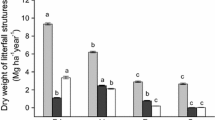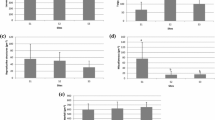Abstract
Litterfall, forest-floor litter biomass and nutrients, short-term litter decomposition and the effects of leaf mulches on initial growth of maize were studied for four indigenous tree species with agroforestry potential:Stryphnodendron microstachyum Poepp. et Endl.(S. excelsum), Vochysia ferruginea Mart,Vochysia guatemalensis Donn. Sm. (V. hondurensis) andHyeronima alchorneoides (O), growing in a young experimental plantation in the Atlantic humid lowlands of Costa Rica. Total annual leaf litterfall was higher inV. ferruginea plots, followed byS. microstachyum, V. guatemalensis andH. alchorneoides; all with values comparable to those reported for other tree species grown in agroforestry combinations in humid tropical regions. Forest-floor litter accumulation was highest underV. ferruginea andV. guatemalensis. Both litterfall and forest-floor litter material had similar patterns in nutrient concentrations: N was higher inS. microstachyum, Ca was higher inV. guatemalensis, K was higher inH. alchorneoides; Mg was higher inV. guatemalensis andH. alchorneoides; H. alchorneoides andV. guatemalensis had the highest P.V. ferruginea litter decomposed more slowly, whileS. microstachyum apparently decomposed faster than the other species. The twoVochysia species showed increases in N and P concentration in decomposing litter after seven weeks in the field,H. alchorneoides showed an increase in litter N and a decrease in litter P, andS. microstachyum showed a net decrease in both N and P over the same time period. The patterns found in the litter bag study were confirmed by results obtained in a tethered-leaves experiment.S. microstachyum andV. ferruginea litters lost more weight when mixed in a 1∶1 proportion than either of them alone. Maize seedlings growing in plots mulched withS. microstachyum andH. alchorneoides leaves showed greatest initial growth, confirming patterns found in decomposition and nutrient release studies. The results show that these species could be used in agroforestry combinations with different advantages according to the specific objectives desired, whether these are soil protection, nutrient recycling, or enhancement of the growth of associated crops.
Similar content being viewed by others
References
Beer J (1988) Litter production and nutrient cycling in coffee (Coffea arabica) or cacao (Theobroma cacao) plantations with shade trees. Agroforestry Systems 7: 103–114
Budelman A (1988) The decomposition of the leaf mulches ofLeucaena leucocephala, Gliricidia sepium andFlemingia macrophylla under humid tropical conditions. Agroforestry Systems 7: 33–45
Budelman A (1989) The performance of selected leaf mulches in temperature reduction and moisture conservation in the upper soil stratum. Agroforestry Systems 8: 53–66
Duguma B, Kang BT and Okali DUU (1988) Effect of pruning intensities of three leguminous species grown in alley cropping with maize and cowpea on an alfisol. Agroforestry Systems 6: 19–35
Espinoza Camacho M and Butterfield R (1989) Adaptabilidad de 13 especies nativas maderables bajo condiciones de plantacion en las tierras bajas humedas del Atlantico, Costa Rica. In: Salazar R, ed, Manejo y Aprovechamiento de Plantaciones Forestales con Especies de Uso Multiple, Actas Reunion IUFRO, Guatemala, 3–7 de abril 1989, pp 159–192. CATIE, Turrialba, Costa Rica
Evans J (1987) Site and species selection — changing perspectives. Forest Ecology and Management 21: 299–310
Gonzalez E (1991) Recoleccion y germinacion de semillas de 26 especies arboreas del bosque humedo tropical. Revista de Biologia Tropical (Costa Rica) 39(1): 47–51
Gonzalez E, Butterfield R, Segleau J and Espinoza M (1990) Primer Encuentro Regional sobre Especies Forestales Nativas de la Zona Norte y Atlantica, Memoria, Chilamate, Costa Rica, 28–29 Julio 1989. Instituto Tecnologico de Costa Rica, Cartago, Costa Rica, 46 pp
Gutteridge RC (1990) The use of the leaf of nitrogen fixing trees as a source of nitrogen for maize. Nitrogen Fixing Tree Research Reports 8: 27–28
Holdridge LR and Poveda LJ (1975) Arboles de Costa Rica. Centro Cientifico Tropical, San Jose, Costa Rica, 546 pp
Hussain A, Ranjha AM, Sharar MS and Ghaffar A (1990) Release of nitrogen during decomposition of legume tree leaves. Nitrogen Fixing Tree Research Reports 8: 51–53
Kaufusi P and Asghar M (1990) Effects of incorporating plant materials on corn growth. Nitrogen Fixing Tree Research Reports 8: 81–82
La Caro F and Rudd RL (1985) Leaf litter disappearance rates in Puerto Rican montane rain forest. Biotropica 19(4): 269–276
Montagnini F and Sancho F (1990a) Influencia de seis especies de arboles nativos sobre la fertilidad del suelo en una plantacion experimental en la llanura del Atlantico de Costa Rica. Yvyrareta (Argentina) 1(1): 29–49
Montagnini F and Sancho F (1990b) Impacts of native trees on tropical soils: a study in the Atlantic lowlands of Costa Rica. Ambio 19(8): 386–390
Montagnini F, Sancho F, Ramstad K and Stijfhoorn E (1991) Multipurpose trees for soil restoration in the humid lowlands of Costa Rica. In: Taylor DA and McDicken KG, eds, Research on Multipurpose Trees in Asia. Proceedings of an International Symposium, November 19–23, 1990, Los Banos, Philippines, pp 41–58. Winrock International Institute for Agricultural Development, Bangkok
Montagnini F and Sancho F (1993a) Nutrient budgets of young plantations with native trees: strategies for sustained management. Paper presented at the workshop: Forests and Wood-Based Biomass Energy as Rural Development Assets. Winrock/Yale University, Old Saybrook, CT, USA, February 23–27, 1992. In press
Montagnini F and Sancho F (1993b) Aboveground biomass and nutrients in young plantations of indigenous trees on infertile soils in Costa Rica: implications for site nutrient conservation. Journal of Sustainable Forestry. In press
Montagnini F and Sancho F (1993c) Reciclaje de nutrientes en plantaciones jovenes con arboles nativos: estrategias para un manejo sustentable. Yvyrareta (Argentina). In press
Okeke AI and Omaliko CPE (1991) Nutrient accretion to the soil via litterfall and throughfall inAcioa barteri stands at Ozala, Nigeria. Agroforestry Systems 16: 223–229
Onim JFM, Mathuva M, Otieno K and Fitzhugh HA (1990) Soil fertility changes and response of maize and beans to green manures of leucaena, sesbania and pigeonpea. Agroforestry Systems 12: 197–215
Palm CA and Sanchez PA (1990) Decomposition and nutrient release patterns of the leaves of three tropical legumes. Biotropica 22(4): 330–338
Palm CA and Sanchez PA (1991) Nitrogen release from the leaves of some tropical legumes as affected by their lignin and polyphenolic contents. Soil Biology and Biochemistry 23(1): 83–88
Pierce SM (1992) La Selva Biological Station history: colonization/land use/deforestation of Sarapiqui, Costa Rica. MS Thesis, Department of Forest Science, Colorado State University, Fort Collins, Colorado, USA, 321 pp
Rout SK and Gupta SR (1987) Effect of chemical composition of leaf litter decomposition on forest soil. Proceedings of the Indian Academy of Science (Plant Science) 97(5): 399–404
Sancho F and Mata R (1987) Estudio detallado de suelos. Estacion Biologica La Selva, Organizacion para Estudios Tropicales, San Jose, Costa Rica, 162 pp
Szott LT, Fernandes ECM and Sanchez PA (1991) Soil-plant interactions in agroforestry systems. Forest Ecology and Management 45: 127–152
Tiraa AN and Asghar M (1990) Corn growth as affected by nitrogen fixing tree and grass plant materials supplemented by P and K fertilizers. Nitrogen Fixing Tree Research Reports 8: 83–84
Yamoha CF and Burleigh JR (1990) Alley croppingSesbania sesban (L) Merill with food crops in the highland region of Rwanda. Agroforestry Systems 10: 169–181
Young A (1989) Agroforestry for Soil Conservation. ICRAF, Science and Practice of Agroforestry. C.A.B. International and International Council for Research in Agroforestry, Wallingford, UK, 276 pp
Author information
Authors and Affiliations
Rights and permissions
About this article
Cite this article
Montagnini, F., Ramstad, K. & Sancho, F. Litterfall, litter decomposition and the use of mulch of four indigenous tree species in the Atlantic lowlands of Costa Rica. Agroforest Syst 23, 39–61 (1993). https://doi.org/10.1007/BF00704850
Issue Date:
DOI: https://doi.org/10.1007/BF00704850




